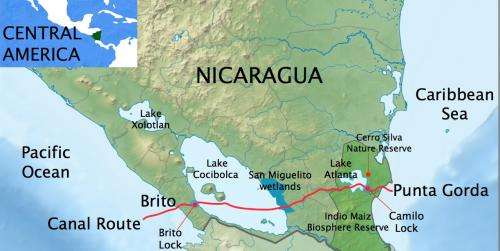Scientists question rush to build Nicaragua canal

A consortium of environmental scientists has expressed strong concern about the impact of a controversial Central American canal across Nicaragua.
The path of the Nicaragua Interoceanic Grand Canal to connect the Atlantic and Pacific oceans will cut through Lake Cocibolca (aka Lake Nicaragua), Central America's main freshwater reservoir and the largest tropical freshwater lake of the Americas; this plan will force the relocation of indigenous populations and impact a fragile ecosystem, including species at risk of extinction, according to Rice University environmental engineer Pedro Alvarez and other members of the consortium.
Alvarez is co-corresponding author of an article that includes 21 co-authors from 18 institutions in the United States and Central and South America who gathered at a multidisciplinary international workshop in Managua, Nicaragua, last November to discuss the project. The paper, titled "Scientists Raise Alarms About Fast Tracking of Transoceanic Canal Through Nicaragua," was published this week by the American Chemical Society journal Environmental Science and Technology.
"The biggest environmental challenge is to build and operate the canal without catastrophic impacts to this sensitive ecosystem," Alvarez said. "Significant impacts to the lake could result from incidental or accidental spills from 5,100 ships passing through every year; invasive species brought by transoceanic ships, which could threaten the extinction of aquatic plants and fish, such as the cichlids that have been evolving since the lake's formation; and frequent dredging, impacting aquatic life through alterations in turbidity and hypoxia, triggered by resuspension of nutrients and organic matter that exert a relatively high biochemical oxygen demand."
A private company, the Hong Kong Nicaragua Canal Development Group, is building the 172-mile, $50 billion canal in collaboration with the Nicaraguan government, which granted the concession last June. Preparation for the project has begun with the construction of roads to move heavy equipment and supplies into place, with the first ships scheduled to pass through the canal in late 2019. It will be longer, wider and deeper than the 51-mile Panama Canal to the south.
Alvarez and his colleagues, including co-correspondent author Jorge Alberto Huete-Pérez, vice-rector and director of the Molecular Biology Center at the University of Central America in Managua, Nicaragua, wrote that dredging required to open a channel in the lake deep and wide enough for ships will disperse enough sediment to lower its oxygen content and kill marine life. They anticipate the project will impact Nicaragua's lucrative ecotourism and the supply of fresh water for drinking, irrigation and power generation.
In a January editorial in Science, Alvarez, Huete-Perez and Axel Meyer, a professor of biology at the University of Konstanz Germany, wrote, "It is incumbent upon scientists, human rights advocates, nongovernmental organizations and wildlife protection organizations to share knowledge, voice concerns, provide guidance and demand a greater role for science in the design and construction of this massive project."
They called for the international scientific community to help "analyze design plans of the canal and its subprojects for safety, social responsibility and sustainability; make recommendations to protect the region's water resources and biodiversity; and draft statements urging the Nicaraguan government to halt construction until studies can be performed and evaluated by experts.
"In this matter of great urgency and importance, this is an opportunity to exercise scientific leadership, raise awareness and contribute to averting a potential environmental disaster," they wrote.
Nicaragua is among countries considered most vulnerable to climate change, the researchers wrote in their latest paper. They are concerned that changes to the watershed could lead to a shortage of water in the event of drought and catastrophic weather events.
The researchers listed their concerns in three broad categories: water and sediments, biodiversity and ecosystem integrity, and socio-economic impact. "Each category involves a number of complex considerations, rendering proper analysis a weighty challenge that is compounded by a lack of publicly available information" from the government and the project's developers and consultants, they wrote.
They acknowledged Nicaragua's hope that the canal, one of the largest engineering projects ever attempted, would create jobs and lift the nation out of extreme poverty; but they are concerned the benefits would not match expectations, particularly since the Nicaraguan government "has not published a detailed business plan for the canal."
"Nicaragua should prepare and publicly vet a detailed economic assessment that includes not only a cost-benefit analysis but also considers externalities associated with national economic development, environmental impacts, social equity, human rights and legal and national security issues," they wrote.
More information: Environmental Science and Technology, pubs.acs.org/doi/abs/10.1021/acs.est.5b00215
Journal information: Environmental Science and Technology
Provided by Rice University




















